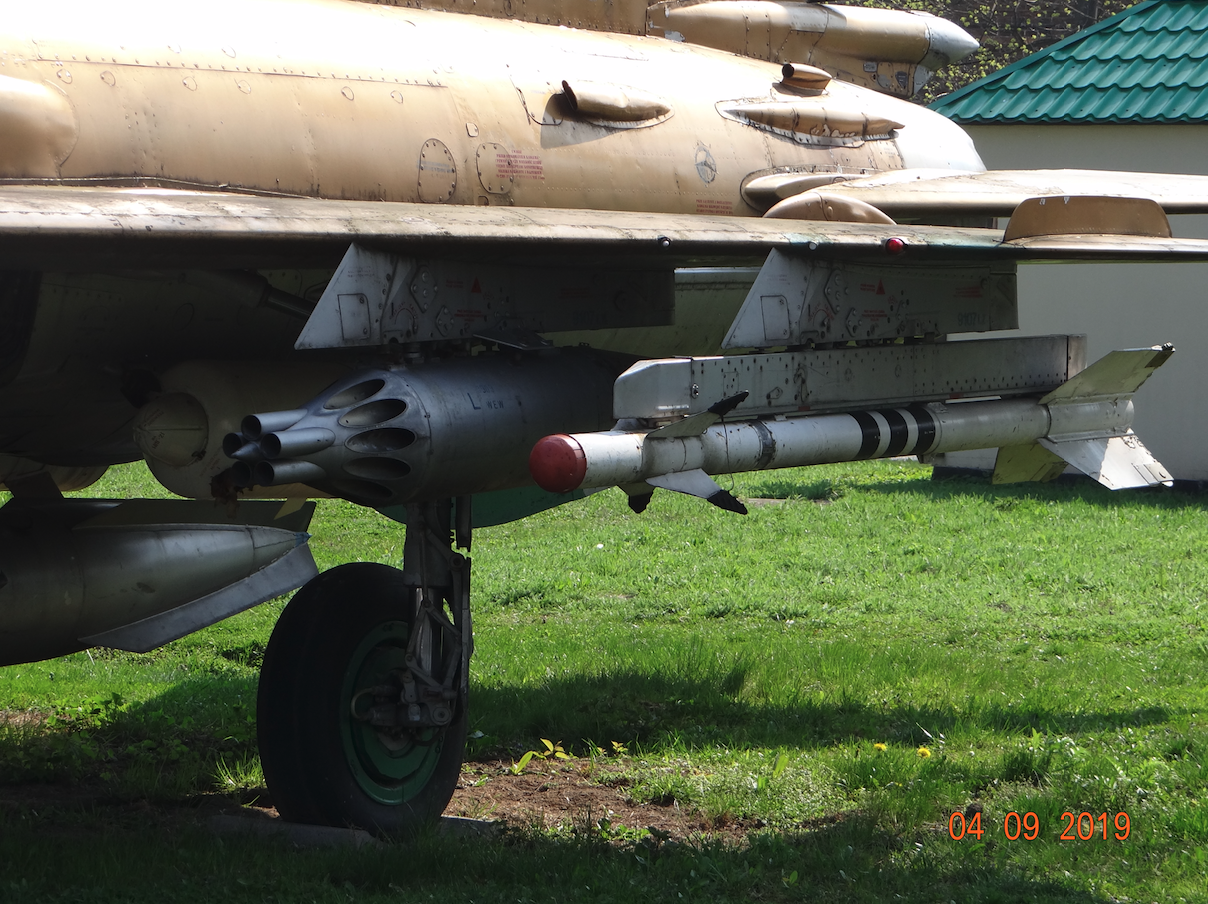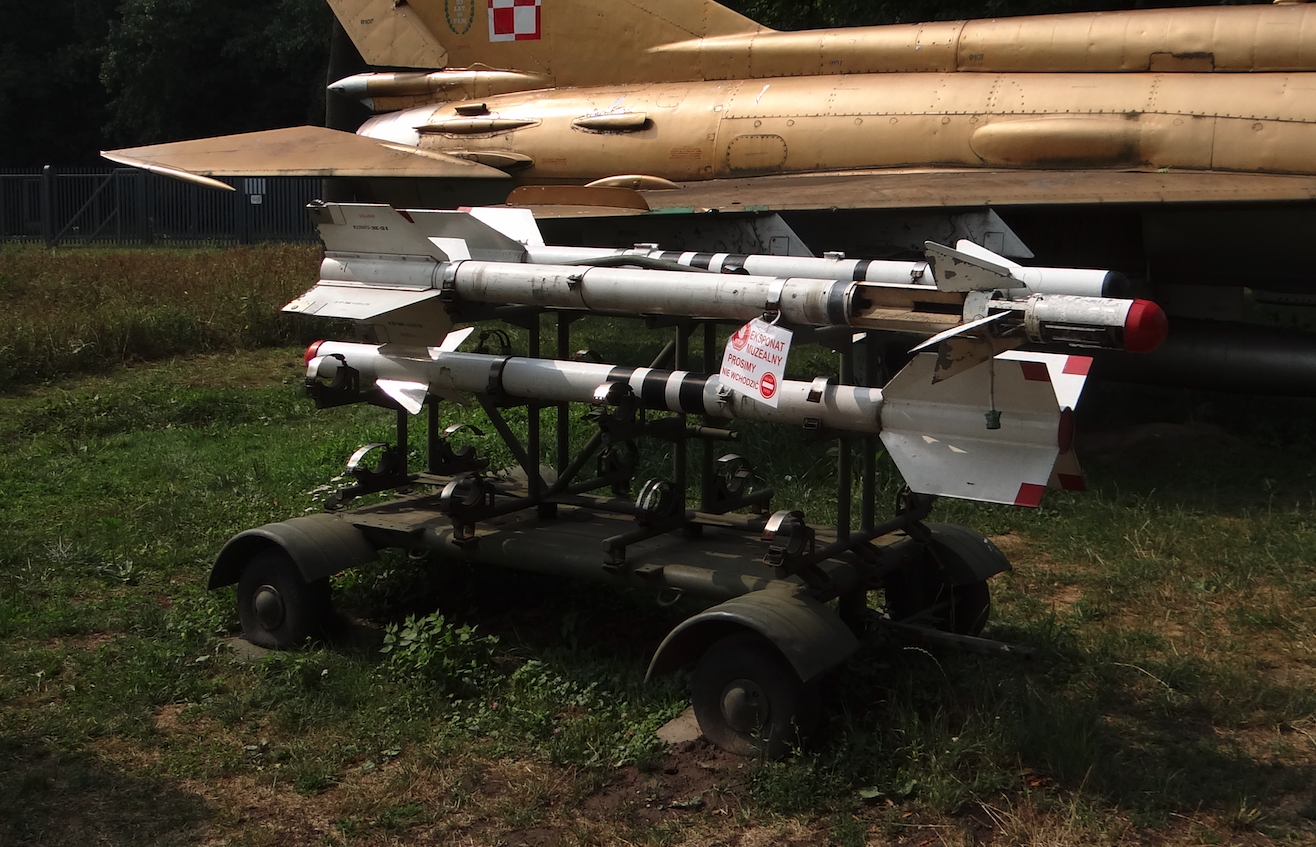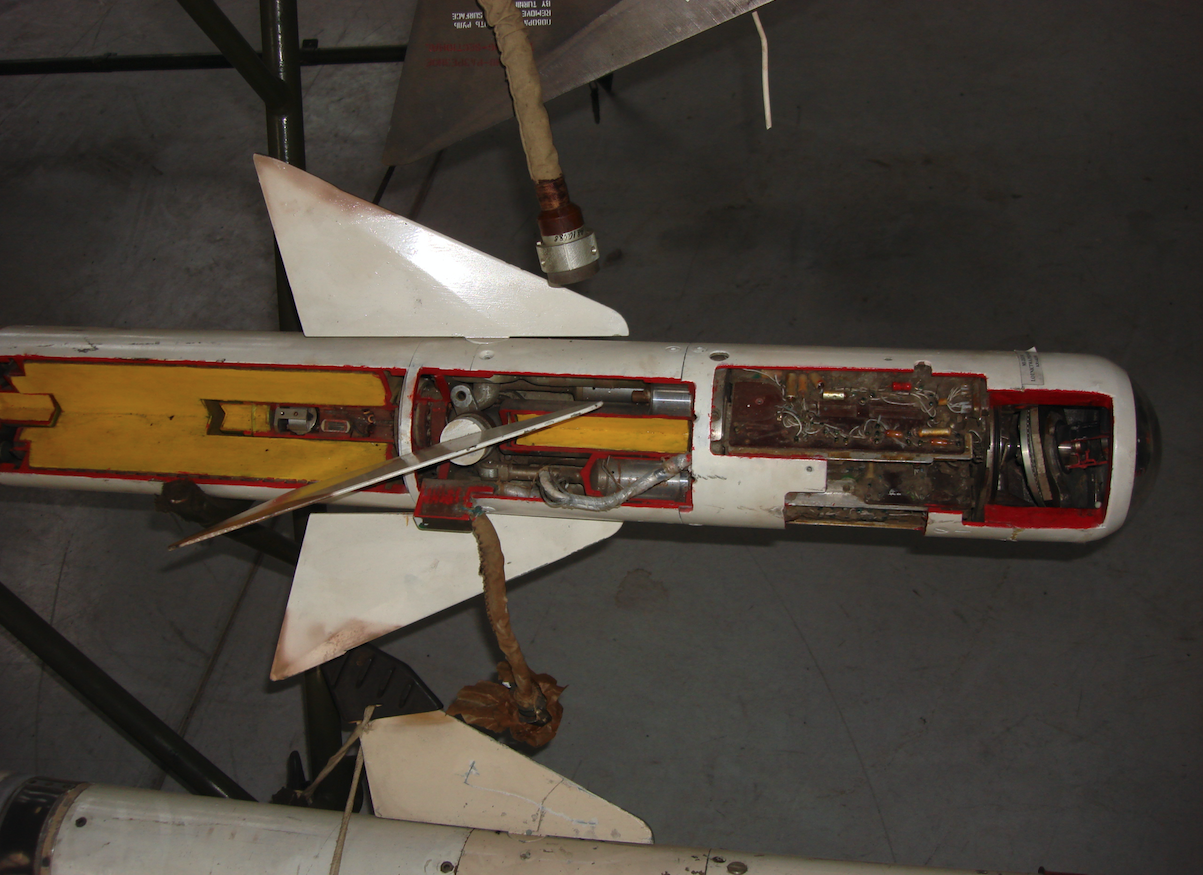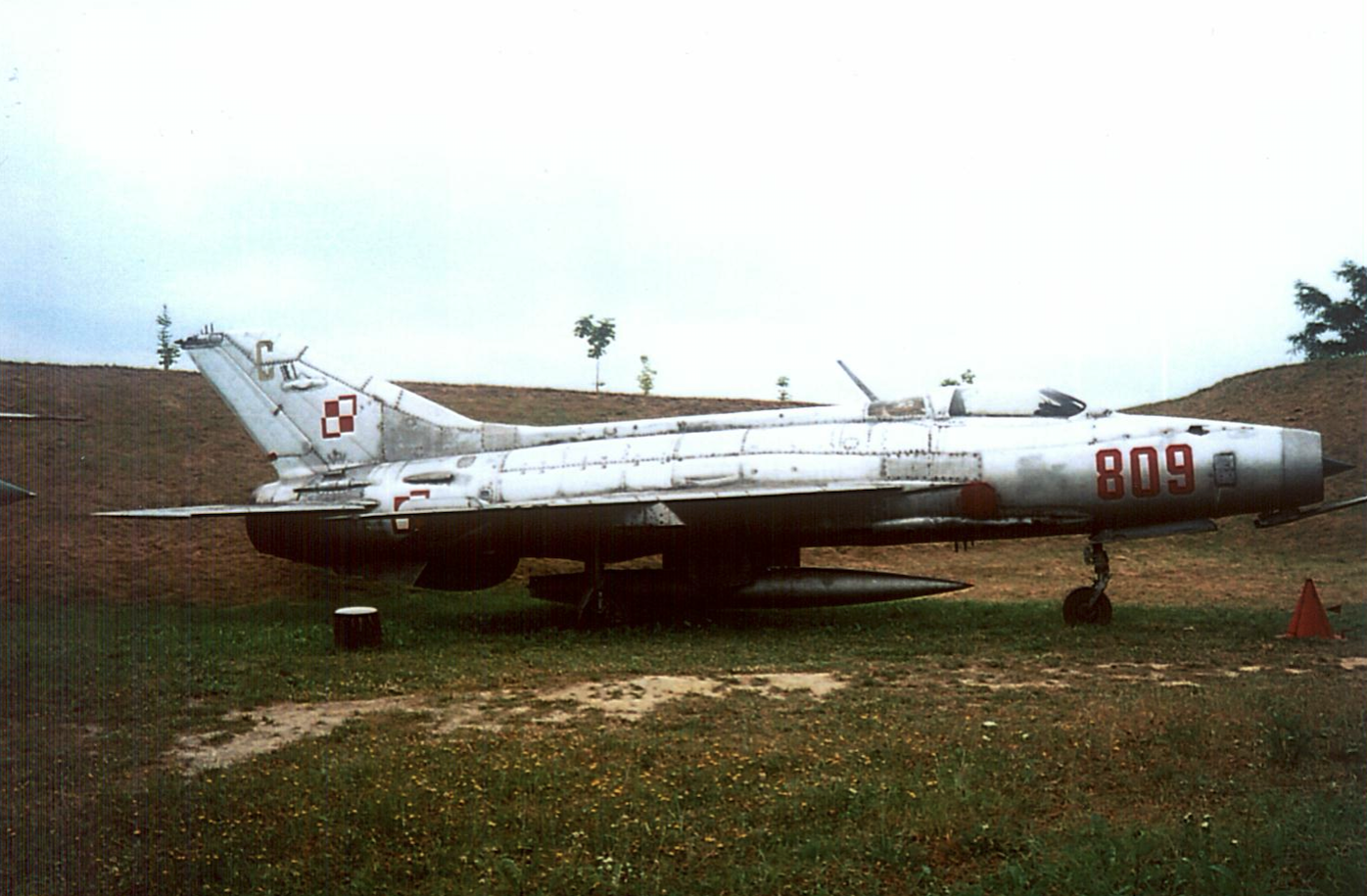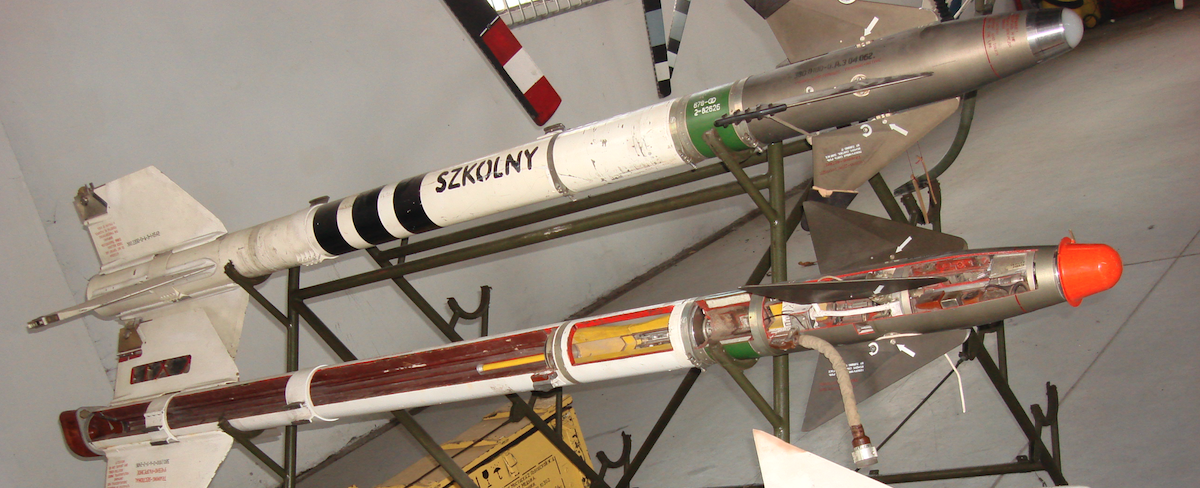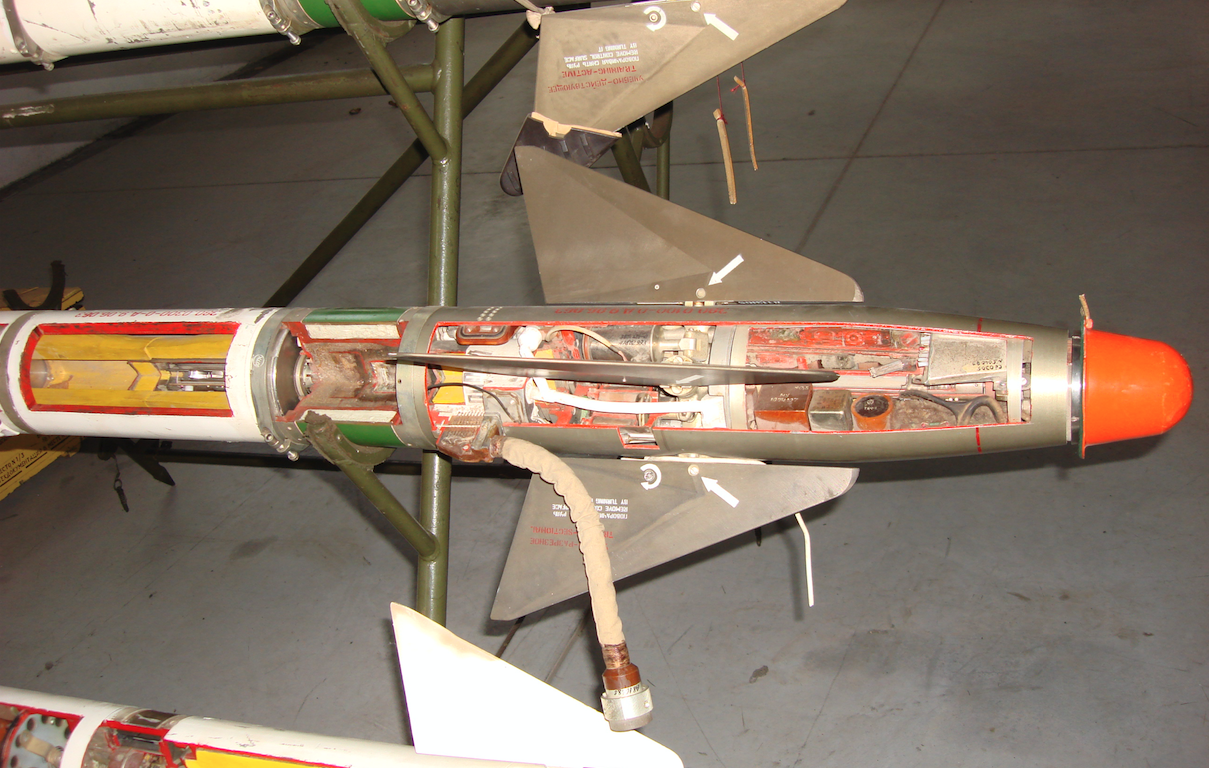Kraków 2020-10-12
Pocisk rakietowy kierowany R-3, R-13M. 2020r.
Pocisk R-3 (K-13).
W drugiej połowie 50-lat, toczyła się wojna pomiędzy Chinami Ludowymi, a Tajwanem, który był wspierany przez USA. Dochodziło do regularnych pojedynków powietrznych pomiędzy samolotami MiG-17 F (Chiny), a F-86 F Sabre (Tajwan). Przewaga zwycięstw samolotów F-86 F była ogromna i wyniosła 10:0. Główny udział w sukcesie miało użycie pocisków kierowanych klasy powietrze-powietrze AIM-9B Sidewinder.
W dniu 1958-09-24 roku, doszło do bezpośredniego trafienia pociskiem AIM-9B Sidewinder, samolotu MiG-17 F. Pocisk jednak nie eksplodował i wbity w samolot, razem z nim wylądował na chińskim lotnisku. O zdarzeniu Chińczycy natychmiast powiadomili Moskwę. Pocisk przewieziono do Moskwy i decyzją władz CCCP z dnia 1958-10-13 roku, został skopiowany i wprowadzony na uzbrojenie.
Rosjan zaskoczyło podejście Amerykanów do systemu kierowania małego pocisku rakietowego. Do tej pory, rosjanie traktowali pocisk rakietowy jako samolot bezpilotowy, którym należy kierować z zewnątrz. Przez to pociski (na przykład RS-1U) były ciężkie, skomplikowane i drogie. Amerykanie postanowili wykorzystać energię cieplną, którą emituje samolot-cel, a zwłaszcza jego gazy wylotowe z silnika. Głowica termiczna ma tylko reagować na temperaturę i kierować pocisk rakietowy w stronę celu.
Tempo prac w CCCP w OKB-134 było bardzo duże. W ciągu dwóch lat nowe pociski weszły do służby, w 1960 roku. Pocisk-kopia oznaczono R-3 (oznaczenie fabryczne) K-13 (oznaczenie wojskowe). Radzieckie testy wykazały, że głowica bojowa o wadze 4,5 kg, jest za mała. O tym wiedzieli już amerykanie, którzy zwiększyli masę głowicy bojowej do 9 kg. Rosjanie zastosowali głowicę bojową o masie 11,3 kg.
W październiku 1959 roku, pociski R-3 testowano na samolotach SM-12, które były rozwojowymi samolotami MiG-19 S. Pociski montowano na wyrzutniach APU-26, a później na zmodyfikowanych APU-13. Celami były bezpilotowe samoloty MiG-15 M. Po udanych testach pociski R-3 (K-13) postanowiono zamontować na samolotach MiG-21 F-13 oraz MiG-21 P-13. Ten drugi miał już celownik radiolokacyjny CD-30T oraz celownik kolimatorowy optyczny PKI. Pocisk R-3 (K-13) potraktowano jako przejściowy i nie produkowano go w dużej ilości.
Od 1962 roku, w produkcji był poprawiony pocisk rakietowy R-3S (K-13A). Miał on lepszy silnik rakietowy, który oznaczono PRD-80A, a którego czas pracy wzrósł z 11 sekund do 21 sekund. Zasięg pocisku wzrósł z 3 500 m do 7 000 m. W tej odmianie pocisk był produkowany masowo w CCCP, w Chinach (PL-2), Rumunii oraz w Polsce w zakładach ZM Mesko.
W kolejnych latach nosicielami pocisków R-3S były wszystkie wersje samolotów MiG-21, samoloty: MiG-23, MiG-27, Su-17, Su-20, Su-22, Jak-28 P.
Opis techniczny pocisku rakietowego R-3S.
Chociaż w 50-latach nie używano określenia – odpal i zapomnij – to pocisk rakietowy R-3S należy do tej klasy. Czyli po jego odpaleniu, pilot może wykonać dowolny manewr, na przykład szukać kolejnego celu. R-3S jest pociskiem klasy powietrze-powietrze, przeznaczonym do niszczenia celów powietrznych. Zwalcza cele z tylnej półsfery, w dzień i w nocy, w dobrych warunkach atmosferycznych. Kierowany jest przy pomocy sensorów termicznych, dlatego jest kierowany na podczerwień.
Pocisk R-3S ma kształt walca, a układ aerodynamiczny jest w układzie kaczka. Czyli usterzenie w przedzie, a skrzydła w tyle. Usterzenie i skrzydła są w układzie krzyżowym.
Wnętrze pocisku podzielono na pięć przedziałów-modułów. Pierwszy z nich mieści pracującą w podczerwieni głowicę samonaprowadzającą TGS-K-13, z koordynatorem optycznym w jej przedniej części. Koordynator optyczny odbiera promieniowanie cieplne emitowane przez cel, przetwarza je, a następnie przekazuje je na fotodetektor zrobiony z siarczku ołowiu (PbS). Ten ostatni zmienia je na impulsy elektryczne, analizowane przez układy elektroniczne głowicy. W pierwszym przedziale mieści się również żyroskopowy układ nadążny. Jego instalacja była konieczna ze względu na ograniczone kąty widzenia detektora optycznego. Stożek jego widzenia wynosi jedynie 3,5 stopni.
W drugim przedziale jest aparatura elektroniczna oraz sekcja mieszcząca siłowniki sterów, turboprądnica i wytwornica gazów. W górnej części umieszczono złącze elektryczne pozwalające na łączność pocisku z samolotem, przekazywanie sygnałów zwrotnych do systemów kierowania uzbrojeniem samolotu, a także zapewniające zasilanie i sterowanie pracą układu kierowania przed startem.
Trzeci z przedziałów mieścił odłamkowo-burzącą głowicę bojową o masie 11,3 kg, wypełnioną heksogenem (flegmatyzowanym trotylem). Korpus ładunku w momencie wybuchu rozrywany jest na 1 000 odłamków, rażących cel w promieniu 10 m.
Czwarta sekcja mieściła optyczny zapalnik zbliżeniowy NOW z 7 fotodetektorami, którego zasięg wykrycia celu wynosił 9 m.
Piąty przedział to silnik rakietowy PRD-80A o ciągu 37 kN. Jednostka napędowa pracuje na paliwie stałym bazującym na nitrocelulozie i nitroglicerynie. Czas pracy silnika wynosił 1,7-3,3 s. W tym czasie rakieta rozpędzała się do prędkości 700 m/s. W tyle pocisku można montować wytwornice dymu, dla obserwacji lotu pocisku.
Skrzydła wyposażono w żyro-lotki odpowiadające za stabilizację prędkości obrotowej pocisku wokół osi podłużnej.
Pocisk ma dwa zapalniki. Pierwszy to zapalnik zbliżeniowy. Drugi to uderzeniowy, którego czujniki są na końcach powierzchni sterowych. Układ samodestrukcji pocisku działa po upływie 23-28 sekund.
Pocisk ma trzy zaczepy do umieszczania na wyrzutni APU-13 lub APU-13U-1. W samolotach MiG-23 używa się belek APU-13MT. Po odpaleniu pocisk rozpoczyna lot kierowany po upływie 0,4-0,7 sekundy. Wychylenia sterów jest wyliczane przez elektronikę termicznej głowicy samonaprowadzającej TGS na podstawie analizy sygnału z fotodetektora.
Procedura ataku pociskiem rakietowym R-3S.
Po wykryciu celu, pilot zajmuje miejsce w tylnej strefie celu. Koordynator optyczny jest zablokowany do momentu zejścia pocisku z wyrzutni APU-13. Pilot umieszcza cel w środku celownika. Po potwierdzeniu świetlnym i dźwiękowym, uzyskanym z systemu sterowania, że głowica rakiety widzi cel, może dojść do odpalenia pocisku. Przed odpaleniem rakiet pilot musi upewnić się, czy prędkość jego samolotu spełnia warunki użycia rakiety i czy nie zostały przekroczone graniczne wartości przeciążeń dla użycia R-3S.
W momencie naciśnięcia przycisku odpalenia następuje uruchomienie pirotechnicznego gazo-generatora napędzającego prądnicę i umożliwiającego funkcjonowanie sterów rakiety. Następnie dochodzi do automatycznego przełączenia zasilania rakiety na źródło wewnętrzne, czyli prądnicę.
W dalszej kolejności odblokowuje się koordynatora optyczny i uruchamia się silnik. Pocisk pokonuje opór zamka, schodzi z wyrzutni i po upływie czasu 0,4-0,7 sekund zaczynał kierować się w stronę celu. Przed końcem pracy silnika rakietowego, dochodzi do uzbrojenia obu zapalników. W przypadku bezpośredniego trafienia eksplozję inicjował zapalnik uderzeniowy. Przy minięciu celu w zasięgu wykrycia celu przez zapalnik zbliżeniowy i to on inicjuje wybuch głowicy bojowej.
Pocisk nie przechwyci celu manewrującego z przeciążeniem większym niż 2g. Pocisk nie jest odporny na pułapki termiczne (flary) i bezpośrednie promienie słoneczne. Pocisk gubi cel, kiedy on wlatuje w chmury. Pocisk może wywołać pompaż silnika samolotu-nosiciela. Dlatego w Polsce, samoloty MiG-23 nie przenosiły pocisków R-3S pod kadłubem. W dodatku, nosiciel na małej wysokości powinien mieć prędkość ponad 800 km/h, a na dużych pułapach ponad 550 km/h.
Podstawowe dane pocisku R-3S:
Wejście do służby był 1960 rok. Średnica pocisku 0,127 m. Długość 2,84 m. Rozpiętość skrzydeł 0,528 m. Masa 75,3 kg. Masa głowicy 11,3 kg. Pułap minimalny użycia 1 000 m. Pułap maksymalny użycia 21 500 m.
Polskie MiG-21 F-13.
MiG-21 F-13 to pierwszy wariant samolotu MiG-21 kupiony przez Wojsko Polskie. Do Polski trafiły wyłącznie samoloty nowe, produkowane w CCCP w zakładzie w Gorki. Samolot jako napęd posiada silnik R-11F-300 o ciągu 1 x 3 822 kG i z dopalaczem 1 x 5 625 kG. Samolot nie posiada celownika radiolokacyjnego (stacji radiolokacyjnej). Pierwszy samolot sprowadzono do Polski w dniu 1961-09-29. Samolot miał numer seryjny 741217 i otrzymał nb 1217. Do Polski dostarczono łącznie 25 sztuk samolotów MiG-21 F-13. Razem z samolotami MiG-21 F-13 dostarczono pociski rakietowe R-3S.
Pocisk R-13M (K-13M).
W ręce radzieckich konstruktorów trafiły pozyskane we Wietnamie Północnym pociski rakietowe AIM-9D. W efekcie doszło do skopiowania nowej głowicy naprowadzającej, która jest chłodzona azotem. Wymieniono również jednostkę napędową pocisku. Poprawiony pocisk otrzymał oznaczenie R-13M (K-13M).
W pocisku R-13M (K-13M) zastosowano układ chłodzenia głowicy przy użyciu azotu. Butla z azotem została umieszczona w belce-wyrzutni. Głowica otrzymała oznaczenie Szron-70. Głowica ma większą czułość fotodetektora. Zwiększyła się dwukrotnie odległość wykrywania celu. Zmniejszono koordynator optyczny. Zmienił się kształt przedniej część pocisku, na bardziej smukły. Pocisk można odpalać przy przeciążeniu do 3,7g. Wzrost zasięgu rakiety uzyskano dzięki wymianie silnika na pracującą również na paliwie stałym (niejednorodnym) jednostkę PRD-280. Ciąg silniki wzrósł do 58,8 kN. Czas pracy zwiększył się do 3,3-5,4 sekundy. Poprawiono zapalnik zbliżeniowy. Generator gazu pracuje trzy razy dłużej. Zwiększono powierzchnie sterowe i skrzydła. Głowica bojowa otrzymała 144 stalowe pręty, które zwiększają efekt niszczący. Samolikwidacja pocisku następuje po 60-65 sekundach.
Ponieważ nadal był problem z pompażem silnika nosiciela pocisk otrzymał specjalny pierścień na dyszy wylotowej, który powoduje zejście pocisku z toru lotu samolotu, a więc ograniczenie zassania gazów. Podstawowe ograniczenia pocisku jednak pozostały, choć skuteczność wzrosła.
Pociski są użytkowane przez samoloty MiG-21 M, MiG-21 MF, MiG-21 bis, MiG-23, MiG-27, Su-20, Su-22 i Su-22 M. Do odpalania pocisków R-13M stosuje się belki podwieszeń APU-13MT, z których można było również odpalać również starsze pociski R-3S.
Pocisk R-3R (K-13R).
Ponieważ konstruktorzy radzieccy liczyli się z fiaskiem programu pocisku R-3S, dlatego równolegle podjęto prace nad wersją z radiolokacyjnym, półaktywnym naprowadzaniem. Głowica naprowadzająca PARG-13MWW kieruje się na cel korzystając z odbitego od celu sygnału radiowego wysokiej częstotliwości emitowanego przez radiolokator nosiciela. Pocisk otrzymał oznaczenie R-3R (K-13R). W pocisku wykorzystano wiele elementów z pocisku rakietowego R-3S. Zachowano zasadniczy rozkład elementów wewnątrz pocisku, znany z R-3S. Długość rakiety wzrosła aż o 0,58 m. Zmianie uległ kształt części czołowej pocisku, który teraz jest ostrym stożkiem, wykonanym z materiału przepuszczającego fale radiowe.
Pocisk musi być używany wyłącznie z celownikiem radiolokacyjnym RP-22 Sapfir. Stacja radiolokacyjna jest niezbędna, ponieważ głowica naprowadzania wyróżnia cel z otoczenia na podstawie odbitego od niego sygnału radiowego wysokiej częstotliwości, którego źródłem jest nadajnik radaru samolotu. Proces ten nazywa się podświetleniem celu. Proces ten jest prowadzony automatycznie przez celownik radiolokacyjny i jest prowadzony do momentu trafienia pocisku w cel.
Pociski R-3R (K-13R) mają także ograniczenia. Praca radaru nosiciela dekonspiruje atak. Można zakłócić sygnał radiowy stacji radarowej emitując fałszywe ślady radiowe.
Pociski R-3R są używane na samolotach MiG-21 S, MiG-21 MS, MiG-21 MB, MiG-21 bis, od 1966 roku. Pocisk R-3R wykorzystuje belkę APU-13U-2. Pociski R-3R były używane także w Polsce na samolotach MiG-21 MF, MiG-21 bis.
Opracował Karol Placha Hetman

